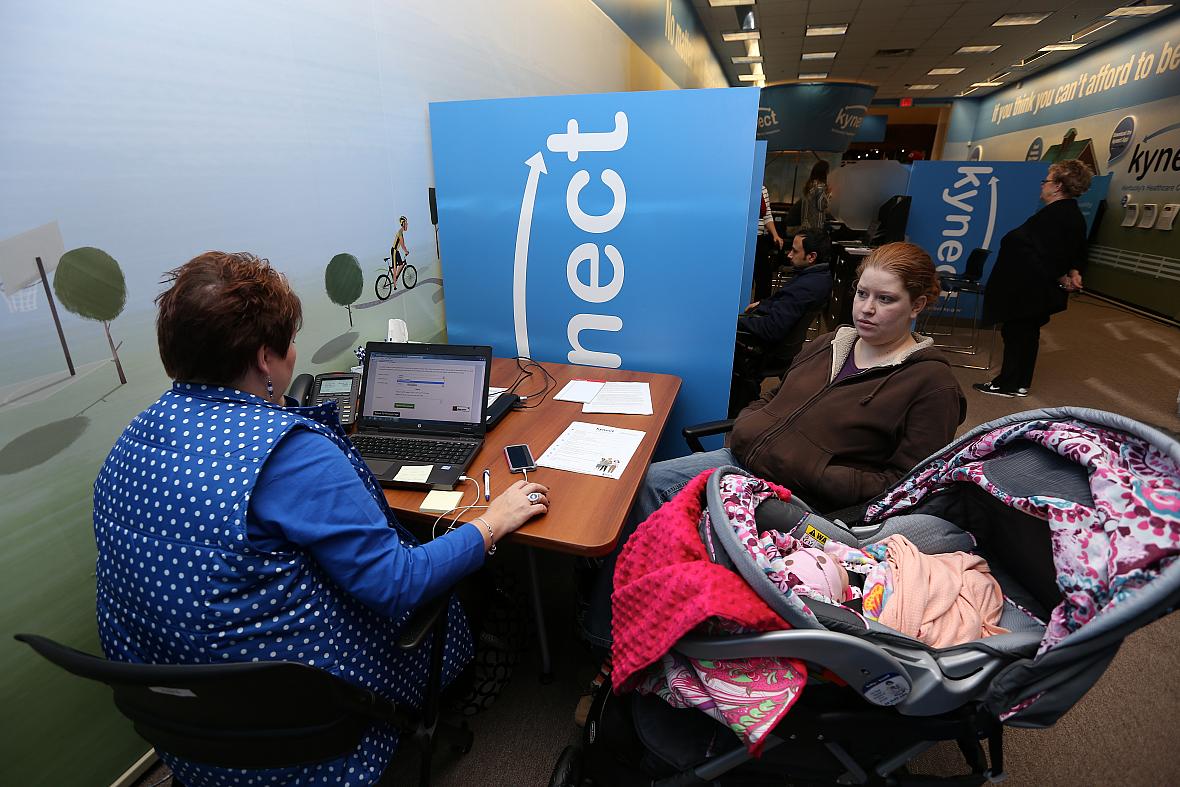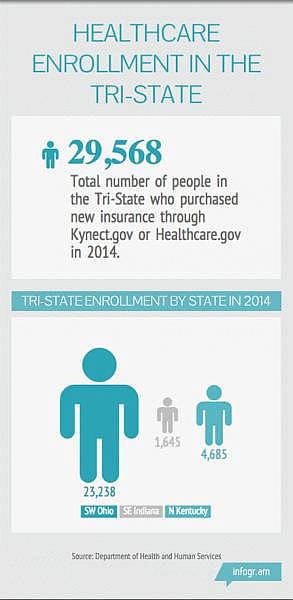Pains and Gains: Marketplace insurance offerings vary on affordability (Part 1)
The impact of unprecedented health reforms is coming into clearer view as millions of Americans work to tap into new insurance benefits ushered in by the Patient Protection and Affordable Care Act, commonly referred to as Obamacare.
Some say the coverage offers the chance for a new way of life.
Others struggle to afford the now mandated health insurance. Still others don’t understand how the new benefits work for them.
The Ohio region boasts examples of the law’s most touted successes and failures. The stories reach beyond the Tri-State, resonating across the country to the nation’s capital where policy makers and politicians are working to revamp or uproot the multi-billion-dollar law meant to curb the country’s escalating health care costs.
This article, the first of five parts, was originally published by WCPO.com

Lexington resident Jennifer Gaines renews her enrollment at a Kynect store in Fayette Mall. Photo: Emily Maxwell | WCPO
The number of people without health insurance has dropped across the region
For thousands in Indiana, coverage is on the way
Rachel Hill has her diabetes under control after two years of not having insurance.
Larry Keller is cancer free and practicing law again after a life-saving surgery, made possible by new insurance coverage.
But a glut of new consumers now covered by Medicaid are waiting as much as four months before they can see a doctor for a routine visit.
Welcome to the growing pains and gains ushered in by the unprecedented shift of people who now have health care coverage.
A full year since the Patient Protection and Affordable Care Act’s most sweeping reforms were put to test, areas of the Tri-State boast a long hoped-for and fundamental outcome of the controversial law: Fewer uninsured Americans.
In Southwest Ohio’s Butler, Clermont, Warren and Hamilton counties more than 80,300 residents have health benefits not open to them before. In Northern Kentucky’s Boone, Campbell and Kenton counties more than 30,000 now have new insurance.
“People are getting over their concerns about this being ‘Obamacare,’ and they’re signing up because the fear of not having coverage and being sick is just not a place you want to be,” said Judith Warren, CEO of Roselawn-based nonprofit Health Care Access Now.
The coverage hasn’t come without challenges.
Some worry that their new insurance means costly, out-of-pocket expense they won’t be able to cover if they get sick.
Others complain the plans don’t cover the doctors they need or worse: They can’t see the doctors they have without lengthy waits.
As the second wave of insurance signups wrap up this month, here’s a by-the-numbers look at the law’s impact.
Kentucky boasts biggest gains
Kentucky is a standout nationally when it comes to health insurance signups.
The percentage of uninsured in the Bluegrass dropped by 8.9 percent in 2014, which was the second sharpest decline in the U.S. just behind Arkansas.
A state long ranked among the worst in the country for diabetes, smoking rates and myriad of chronic diseases, Kentucky’s lead role in insurance sign-ups nationally is a welcome success for state policy makers.
“I don’t care what your politics are – Richard Nixon could have passed this law. We needed something transformational to make a generational and historic change for the future of Kentuckians," said Gov. Steven Beshear.
State officials attribute the success to the ease of signing on to new insurance through Kentucky’s online marketplace – Kynect.ky.gov.
The remaining states, including Ohio and Indiana, opted to let the federal government run their marketplaces hosted at Healthcare.gov.
While the federal site faced massive coding errors and crashes during its debut in 2014, Kynect continues to be a national success story touted by President Barack Obama for its mostly glitch-free design. Now, other states are turning to Kentucky, and at least one state – Oregon - is scrapping its own state-based exchange to build one that models Kynect.
Medicaid expansion fuels new coverage boom
States like Kentucky and Ohio that expanded Medicaid coverage – a key option under health reform - have enrolled millions of low-income Americans into the joint state-federal health insurance program.
In Southwest Ohio and Northern Kentucky, Medicaid enrollment sign-ups account for more than 70 percent of the gains in newly insured residents.
The rest with new coverage bought plans through the new federally-run and state-based marketplaces created to offer discounts to those buying health insurance on their own. The web-based marketplaces, also called exchanges, are considered critical for consumers who are self-employed or don’t get insurance through their employer.
Across the Tri-State more than 29,000 plans were sold through the first wave of open enrollment, which ended in March 2014.
In Southwest Ohio and Northern Kentucky, Medicaid enrollment sign-ups account for more than 70 percent of the gains in newly insured residents.
The rest with new coverage bought plans through the new federally-run and state-based marketplaces created to offer discounts to those buying health insurance on their own. The web-based marketplaces, also called exchanges, are considered critical for consumers who are self-employed or don’t get insurance through their employer.
Across the Tri-State more than 29,000 plans were sold through the first wave of open enrollment, which ended in March 2014.
So far this year, sign-ups have been more robust compared to 2014 when Healthcare.gov was plagued by weeks of glitches and crashes. Officials expect Ohio to nearly double enrollment in marketplace plans from roughly 155,000 to nearly 300,000, says Trey Daly, Ohio director for Enroll America, a national nonprofit working to sign up uninsured.
“We know a major barrier for people who did not enroll in the first round was the lack of information and awareness of the financial assistance available,” said Daly.
Through early January, more than 196,000 Ohioans have enrolled, with 52 percent re-enrolling from last year, according to federal Department of Health and Human Services.
In Kentucky, more than 100,000 have signed on with more than 90 percent re-enrolling. In Indiana, more than 175,000 have enrolled. The latest data available on enrollment doesn’t include county-level statistics.
This year, open enrollment to buy a plan through the new marketplaces runs through February 15. But unlike the marketplace, enrollment in Medicaid is open throughout the year.
Source: Department of Health & Human Services
The gains in the Bluegrass and Buckeye states are in sharp contrast to neighbors just miles away in Indiana.
Indiana was one of 28 states that opted against expanding Medicaid coverage. And it saw its percentage of uninsured adults actually drop – moving from 15.3 percent in 2013 to 15 percent last year.
Last month Indiana Gov. Mike Pence announced the state will pursue its own alternative plan to Medicaid expansion.
The move would pave the way for coverage for an estimated 350,000 Hoosiers who currently remain uninsured and stuck in a coverage gap. They’re ineligible for Medicaid but don’t make enough to qualify for tax credits available through the marketplace that would offset their insurance costs.
“The sad part is, these are people who are trying hard to earn a living, and they can’t get the same coverage as folks just a few miles away because they’re a Hoosier," said Roger Howard, CEO of Dearborn County Hospital
The ACA is projected to cut the number of uninsured by 56 percent by 2016 when the health law is fully intact. But experts project millions of people in the U.S. still will remain uninsured for a variety of reasons.
Immigrants in the country illegally, for example, don’t qualify for coverage.
An analysis funded by the Robert Wood Johnson Foundation and Urban Institute projects that as many as 27.1 million Americans will be uninsured in 2016.
Among those:
- 37 percent would be eligible for coverage under Medicaid, but just aren’t aware.
- 22 percent are in states that didn't expand Medicaid
- 17 percent are higher-income people who aren't eligible for tax credits through the exchange, but choose not to buy insurance on their own.
Back in Indiana, officials say the federal government’s recent approval for its Medicaid plan is welcome news after eight months of negotiating on finer points of the plan.
“This has been a long process,’’ Pence said, “but real reform takes work.”
Photo Credit: Emily Maxwell/WCPO

